YouTube for Business: A Marketing Essential

YouTube has evolved from a simple video-sharing site to an essential marketing tool for businesses of all sizes. With over 2 billion active users monthly, YouTube offers a massive audience that businesses can tap into. This guide will walk you through the importance of YouTube for business, how to set up your channel, create content, optimise for SEO, engage with your audience, and much more.
Key Takeaways
- YouTube is a powerful platform with over 2 billion active users every month.
- Setting up a YouTube business channel involves creating an account, customising your channel, and adjusting essential settings.
- Effective content creation on YouTube includes understanding what types of content perform well and using the right tools for production.
- Optimising your YouTube videos for SEO can significantly increase your reach and visibility.
- Engaging with your audience through comments, community posts, and live interactions can build a loyal following.
Understanding the Power of YouTube for Business
The Evolution of YouTube as a Marketing Tool
YouTube has come a long way since its launch in 2005. Initially a platform for sharing personal videos, it has evolved into a powerful marketing tool. Businesses now use YouTube to reach millions of potential customers. The platform’s growth has been phenomenal, with over 2.6 billion users worldwide. This makes it an essential part of any modern marketing strategy.
Why YouTube is Crucial for Modern Marketing
In today’s digital age, video content is king. YouTube’s search engine capabilities boost discoverability, ensuring that businesses can be found by users actively seeking relevant products or services. The integration of advertising options, such as TrueView and YouTube Ads, allows for targeted and cost-effective campaigns. Being on YouTube is not just a marketing strategy but an indispensable tool for cultivating brand visibility and ultimately driving business success.
Case Studies of Successful YouTube Campaigns
Many businesses have leveraged YouTube to achieve remarkable success. For instance, Blendtec’s “Will It Blend?” series went viral, significantly boosting their brand awareness and sales. Another example is Dollar Shave Club, whose humorous and engaging videos helped them gain a massive following and increase their market share. These case studies highlight the potential of YouTube as a marketing powerhouse.
YouTube’s vast user base and advanced targeting options make it an unparalleled platform for businesses looking to expand their reach and engage with their audience effectively.
Setting Up Your YouTube Business Channel
Creating a Business YouTube Account
First, we need to create a YouTube channel for our business. Since YouTube is part of Google, we must have a Google account. We can use an existing account or create a new one specifically for managing our business channel.
Here’s how to get started:
- Create a Google account or use your existing one.
- Go to YouTube.com and click the profile photo in the top right corner.
- Click ‘Create a channel’ from the dropdown menu.
- Enter your business name and handle, then upload your logo as your profile photo.
Once done, we’ll be taken to our brand-new YouTube channel!
Customising Your Channel for Branding
Customising our channel is crucial for branding. We need to fill out the following details:
- Basic info: Name, handle, description, channel URL, external links, and contact information.
- Branding: Profile picture, channel art/banner image, and video watermark.
- Layout: Video spotlight and featured sections.
A well-branded channel helps in gaining subscribers and building a strong online presence.
Essential Settings and Features
To make the most of our YouTube business channel, we should explore and utilise essential settings and features. These include:
- Channel description: A concise mission statement with relevant links.
- Links section: Add links to our business website, social media accounts, and other web pages.
- Channel trailer: An optional but effective way to introduce viewers to our content.
Customising our YouTube channel not only enhances our brand’s visibility but also helps in engaging our audience effectively.
Content Creation Strategies for YouTube
Types of Content That Perform Well
Creating the right type of content is crucial for success on YouTube. We need to focus on what our audience wants to see. Customer testimonials, product demonstrations, and explainer videos are some of the most effective types. These videos not only engage viewers but also build trust and credibility. Additionally, experimenting with YouTube Shorts can help us reach a broader audience quickly.
Scripting and Storyboarding Your Videos
Before hitting the record button, it’s essential to have a clear plan. Scripting and storyboarding our videos ensure that we stay on track and cover all necessary points. A well-written script helps maintain a logical flow, making it easier for viewers to follow along. Storyboarding, on the other hand, helps us visualise each scene, ensuring that our video is both engaging and informative.
Tools and Software for Video Production
Having the right tools can make a significant difference in the quality of our videos. Basic equipment like a good camera, microphone, and lighting setup is essential. For editing, software like Adobe Premiere Pro or Final Cut Pro can help us create professional-looking videos. Additionally, using graphic design tools like Canva can enhance our videos with eye-catching visuals.
Consistently creating high-quality content is key to standing out on YouTube. It’s not just about the quantity but the quality of the videos we produce.
By focusing on these strategies, we can create compelling content that resonates with our audience and helps us achieve our marketing goals.
Optimising Your YouTube Videos for SEO
Keyword Research for YouTube
To start, we need to know what people are searching for. Keyword research helps us find the phrases viewers use. Tools like Google Keyword Planner are great for this. We can also type our topic into the YouTube search bar to see what comes up. These are real searches from real people.
Using Tags and Descriptions Effectively
Adding keywords to our video is crucial. We should have one main keyword and a few extra ones. Here’s where to add them:
- Video title: Make sure the main keyword is prominent.
- Video description: Include the main keyword in the first three sentences. Add 1-2 related keywords.
- Video tags: Use your keywords as tags. Tools like TubeBuddy can help find more relevant tags.
- Hashtags: Add 1-2 hashtags with your main keyword at the bottom of your video description.
The Role of Thumbnails and Titles
Thumbnails and titles are the first things viewers see. A good thumbnail can make a big difference. It should be custom, not just a screenshot. Use a photo or brand elements and add some text to lure viewers in. Titles should be clear and compelling. They should make viewers curious or show that the video will solve a problem.
Remember, optimising your YouTube videos is not just about adding keywords. It’s about making your content easy to find and engaging for viewers.
By following these steps, we can ensure our videos rank higher and reach more people.
Engaging with Your Audience on YouTube
Responding to Comments and Feedback
Engaging with your audience starts with responding to comments and feedback. When viewers leave comments, they expect a response. Timely replies show that we value their input and are listening. This interaction can turn casual viewers into loyal subscribers. We should also address any negative feedback constructively, showing that we are committed to improving.
Creating Community Posts
Community posts are a fantastic way to keep our audience engaged between video uploads. These posts can include polls, images, or text updates. They help us stay connected with our audience and keep them informed about upcoming content. By asking questions or running polls, we can gather valuable insights into what our viewers want to see next.
Utilising YouTube Live for Real-Time Interaction
YouTube Live is an excellent tool for real-time interaction. Live streaming allows us to connect with our audience in a more personal and immediate way. We can host Q&A sessions, live tutorials, or behind-the-scenes looks at our projects. This real-time engagement can significantly boost our channel’s visibility and foster a stronger community.
Engagement begets engagement, so stay active and interact with others on the platform to build audience engagement.
In summary, engaging with our audience on YouTube involves timely responses to comments, creating interactive community posts, and leveraging YouTube Live for real-time interaction. By doing so, we can build a loyal and engaged community around our channel.
Advertising on YouTube
Types of YouTube Ads
There are several ways to advertise on YouTube:
- In-stream ads: These play before, during, or after other videos. Users can skip the ad after five seconds, and you only pay when a viewer watches for 30 seconds or interacts with it.
- Discovery ads: These appear when users search or browse content on YouTube. They can be any length, and you pay when someone clicks to watch the full video.
- Bumper ads: These are six seconds or less and cannot be skipped. They appear before, during, or after another video.
- Outstream ads: These play only on mobile devices, appearing on partner websites and within apps. You pay based on cost per thousand viewable impressions.
Setting Up Your First YouTube Ad Campaign
To create a campaign, follow these steps:
- Go to your Google AdWords account and select “New Campaign.”
- Choose “Video” as your campaign type.
- Select a goal, such as Sales, Leads, Website traffic, Product and brand consideration, or Brand awareness and reach.
- Name your campaign, set a budget, and choose a timeline. Define your bidding strategy, ad networks, target language(s), and location(s).
- Set any content exclusions, choose devices for your ad, and cap the frequency of your ads.
Measuring Ad Performance
Tracking the performance of your ads is crucial. Use YouTube Analytics to monitor key metrics like views, watch time, and engagement. Understanding these metrics helps you refine your strategy and improve future campaigns.
Effective advertising campaigns are essential for overcoming challenges like supply chain disruptions in e-commerce. By optimising budgets and generating leads, businesses can enhance profitability.
For more detailed insights, consider a Google ads audit or consult with a PPC agency. This can help you identify areas for improvement and ensure your campaigns are as effective as possible.
Leveraging YouTube Analytics
Understanding YouTube Analytics Dashboard
Navigating the YouTube Analytics dashboard can seem overwhelming at first. However, once we get the hang of it, it becomes an invaluable tool. The dashboard provides a comprehensive overview of how our videos are performing. We can see metrics like views, watch time, and subscriber growth. It’s essential to regularly check these metrics to understand what content resonates with our audience.
Key Metrics to Track
There are several key metrics we should focus on:
- Views: The number of times our video has been watched.
- Watch Time: The total amount of time viewers have spent watching our videos.
- Audience Retention: How well our videos keep viewers engaged.
- Engagement: Includes likes, comments, and shares.
- Traffic Sources: Where our viewers are coming from, such as search, suggested videos, or external websites.
Tracking these metrics helps us understand our audience better and tailor our content to their preferences.
Using Analytics to Improve Content
By analysing our YouTube data, we can make informed decisions to enhance our content strategy. For instance, if we notice a particular type of video is performing well, we can create more of that content. Additionally, understanding our traffic sources can help us optimise our promotion strategies. Regularly reviewing our analytics ensures we stay aligned with our audience’s interests and preferences.
Consistently leveraging YouTube Analytics allows us to refine our content and marketing strategies, ensuring we meet our business goals effectively.
Monetising Your YouTube Channel
Joining the YouTube Partner Programme
To start earning from your YouTube channel, you need to join the YouTube Partner Programme. This programme allows you to make money from ads shown on your videos and from YouTube Premium subscribers watching your content. To be eligible, your channel must have 4,000 watch hours in the past 12 months and at least 1,000 subscribers. Alternatively, you can qualify if you have 1,000 subscribers and 10 million views on your Shorts in the last 90 days.
Tip: You can check your watch time and subscriber count in the YouTube Analytics dashboard.
Alternative Monetisation Strategies
Besides the YouTube Partner Programme, there are other ways to monetise your channel:
- Channel Memberships: Offer exclusive perks to subscribers who pay a monthly fee.
- Super Chat and Super Stickers: Earn money from fans during live chats.
- Merchandise Shelf: Sell your branded merchandise directly on YouTube.
- YouTube Premium Revenue: Earn a share of the subscription fee when YouTube Premium members watch your content.
Maximising Ad Revenue
To maximise your ad revenue, focus on creating engaging content that keeps viewers watching. The longer they stay, the more ads they see, and the more revenue you earn. Additionally, use YouTube Analytics to understand which videos perform best and why. This data can help you tailor your content strategy to boost views and engagement.
Remember, consistency is key. Regular uploads keep your audience engaged and coming back for more, which in turn increases your revenue potential.
Integrating YouTube with Other Marketing Channels
Cross-Promoting on Social Media
Sharing your YouTube videos on social media is a great way to reach a wider audience. Platforms like Facebook, Twitter, and Instagram make it easy to share video content. Simply click the “Share” button under your YouTube video and select the social media platform you want to share it on. Don’t forget to use relevant hashtags to increase visibility.
Embedding Videos on Your Website
Adding YouTube videos to your website can enhance user engagement. To embed a video, copy the embed code found under the video and paste it into your website’s HTML. This not only keeps visitors on your site longer but also boosts your YouTube views. Check step-by-step embed instructions to ensure you do it correctly.
Collaborating with Influencers
Partnering with influencers can give your YouTube channel a significant boost. Influencers already have a dedicated following, and their endorsement can lend credibility to your brand. Look for influencers whose audience aligns with your target market. Collaborations can range from guest appearances to co-created content.
Integrating YouTube with other marketing channels is essential for a cohesive marketing strategy. It allows us to leverage the strengths of each platform to maximise our reach and engagement.
Legal and Ethical Considerations for YouTube Marketing
Understanding Copyright and Fair Use
Navigating copyright laws is crucial for any business using YouTube. We must ensure that all content we upload is either original or properly licenced. Using copyrighted material without permission can lead to severe penalties. Fair use is a grey area, but it generally allows for limited use of copyrighted material for purposes like commentary, criticism, or parody. However, it’s always safer to seek permission or use royalty-free resources.
Adhering to YouTube’s Community Guidelines
YouTube has a set of community guidelines that we need to follow to keep our channel in good standing. These guidelines cover a range of issues, from hate speech and harassment to misleading metadata. Violating these rules can result in video removal or even channel termination. It’s essential to stay updated with these guidelines as they can change over time.
Ethical Advertising Practises
Ethical advertising is not just about following the law; it’s about building trust with our audience. We should be transparent about sponsored content and avoid misleading claims. Honesty in advertising helps in maintaining a loyal customer base. Additionally, we should respect user privacy and comply with data protection regulations like GDPR.
Ethical considerations are not just about compliance; they are about building a sustainable and trustworthy brand.
By adhering to these legal and ethical standards, we can create a positive and lasting impact on our audience while avoiding potential legal issues.
Future Trends in YouTube Marketing
The Rise of Short-Form Content
Short-form content is becoming increasingly popular. With the introduction of YouTube Shorts, we can now create engaging videos that are just a few seconds long. This format is perfect for capturing the attention of mobile users who prefer quick, digestible content. YouTube Shorts has already reached billions of views daily, making it a must-use feature for marketers.
Augmented Reality and Virtual Reality
Augmented Reality (AR) and Virtual Reality (VR) are set to revolutionise YouTube marketing. These technologies offer immersive experiences that can captivate audiences in ways traditional videos cannot. Imagine giving your viewers a virtual tour of your product or service. This level of engagement can significantly boost your brand’s appeal.
Personalised Video Marketing
Personalisation is the future of marketing, and YouTube is no exception. By leveraging data analytics, we can create tailored content that speaks directly to individual viewers. This approach not only enhances user experience but also increases viewer retention and conversion rates.
Staying ahead of these trends will be crucial for any business looking to maximise their YouTube marketing efforts.
Conclusion
In summary, the future of YouTube marketing is bright and full of opportunities. By embracing short-form content, AR and VR, and personalised video marketing, we can stay ahead of the curve and continue to engage our audiences effectively.
YouTube marketing is evolving fast, and staying ahead of the trends is key. From interactive videos to AI-driven content, the future holds exciting possibilities. Don’t miss out on these opportunities. Visit our website to learn more and get a free PPC audit today!
Conclusion
In conclusion, YouTube has proven itself to be an invaluable tool for businesses of all sizes. By leveraging the platform’s vast audience and robust features, companies can significantly enhance their brand visibility and engage with potential customers in a meaningful way. Whether it’s through creating compelling video content, optimising for search, or running targeted ad campaigns, the opportunities are endless. As the digital landscape continues to evolve, integrating YouTube into your marketing strategy is not just an option but a necessity for staying competitive. So, take the plunge and start harnessing the power of YouTube for your business today.
Frequently Asked Questions
What is YouTube for Business?
YouTube for Business is using YouTube to promote your brand, products, or services. It involves creating videos to reach a larger audience, engage with customers, and drive sales.
Why should I use YouTube for my business?
YouTube is the second-largest search engine in the world. It can help you reach a wide audience, improve your SEO, and increase brand visibility. Plus, videos are a great way to show off your products and connect with customers.
How do I set up a YouTube business channel?
To set up a YouTube business channel, you need to create a Google account, go to YouTube, and create a new channel. Choose a name that reflects your business, and customise the channel with your branding.
What kind of content should I post on my YouTube business channel?
You can post a variety of content, such as product demos, how-to videos, behind-the-scenes looks at your business, customer testimonials, and more. The key is to provide value and engage your audience.
How can I optimise my YouTube videos for better search results?
To optimise your videos, use relevant keywords in your titles, descriptions, and tags. Create engaging thumbnails and include links to your website or social media. Consistently post high-quality content to keep viewers coming back.
What are YouTube ads and how do they work?
YouTube ads are paid advertisements that appear on YouTube videos. They can be in the form of skippable or non-skippable video ads, display ads, or overlay ads. You can target these ads based on demographics, interests, and behaviours.
Can I make money from my YouTube business channel?
Yes, you can make money from your YouTube business channel through the YouTube Partner Programme, which allows you to earn revenue from ads. You can also explore other monetisation options like sponsored content and merchandise sales.
How do I measure the success of my YouTube marketing efforts?
You can measure the success of your YouTube marketing efforts using YouTube Analytics. This tool provides insights into your video views, watch time, audience demographics, and engagement metrics. Use this data to improve your content and strategy.
Author
Search Blog
Free PPC Audit
Subscribe to our Newsletter
The Voices of Our Success: Your Words, Our Pride
Don't just take our word for it. With over 100+ five-star reviews, we let our work-and our satisfied clients-speak for us.
"We have been working with PPC Geeks for around 6 months and have found Mark and the team to be very impressive. Having worked with a few companies in this and similar sectors, I rate PPC Geeks as the strongest I have come across. They have taken time to understand our business, our market and competitors and supported us to devise a strategy to generate business. I value the expertise Mark and his team provide and trust them to make the best recommendations for the long-term."
~ Just Go, Alasdair Anderson




